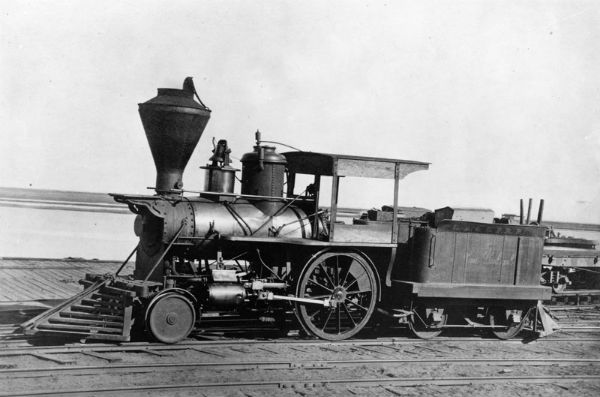October 26, 1869 - Los Angeles & San Pedro RR
 The "San Gabriel" (2-2-0) was the first steam locomotive to haul freight and passengers between Los Angeles and San Pedro. (Photo Collection, Los Angeles Public Library)
The "San Gabriel" (2-2-0) was the first steam locomotive to haul freight and passengers between Los Angeles and San Pedro. (Photo Collection, Los Angeles Public Library)
Built between 1868 and 1869, the 21-mile line connected Los Angeles with the shipping harbor of San Pedro.
The railroad was the brainchild of Phineas Banning, who made some of the first improvements to the harbor, dredging a channel and building a wharf (Banning also developed the port town of Wilmington).
As a California state senator, Banning sponsored a bill authorizing the City and County of Los Angeles to finance construction of the railroad. The city and county then awarded Banning a contract to construct the line.
When it opened on October 26, 1869, a crowd of 1,500 (roughly one-quarter of L.A.'s population at the time) converged on the rail depot at Alameda and Commercial to celebrate Banning's triumph.
While an ox-cart and wagon road had connected Los Angeles to the harbor for decades, the railroad slashed the cost of transporting goods and passengers.
The railroad charged $6 per ton to transport inbound dry goods to the city. Outbound grain cost $2.50 per ton to ship, and passengers could buy a one-way ticket to the port for $1.50. Total commerce at the harbor more than doubled from 26,000 net tons of freight in 1869 to 55,000 in 1871.
Investments in the port by the Army Corps of Engineers and the Southern Pacific Railroad (which bought Banning's 21-mile line in 1872) seemed to ensure that San Pedro Bay would be the site of the region's harbor.
Everything changed in the early 1890s, when the Southern Pacific abruptly abandoned the Wilmington and San Pedro ports and instead began routing its freight trains to Santa Monica.

 Share Article
Share Article